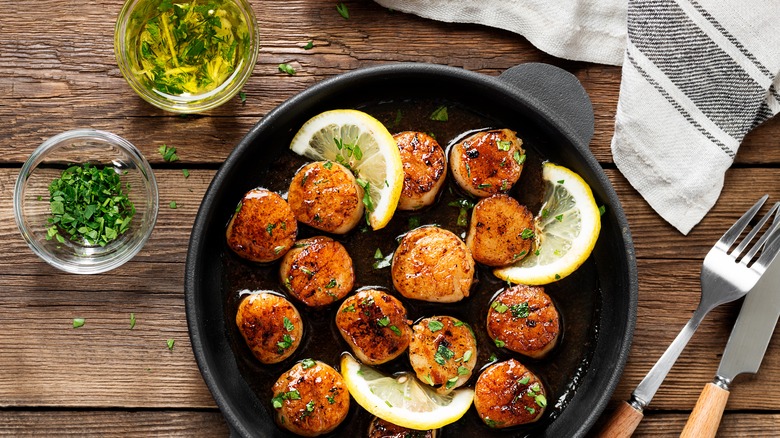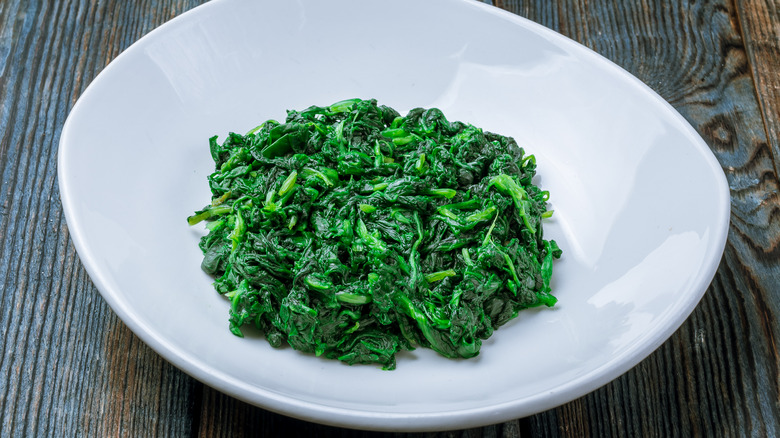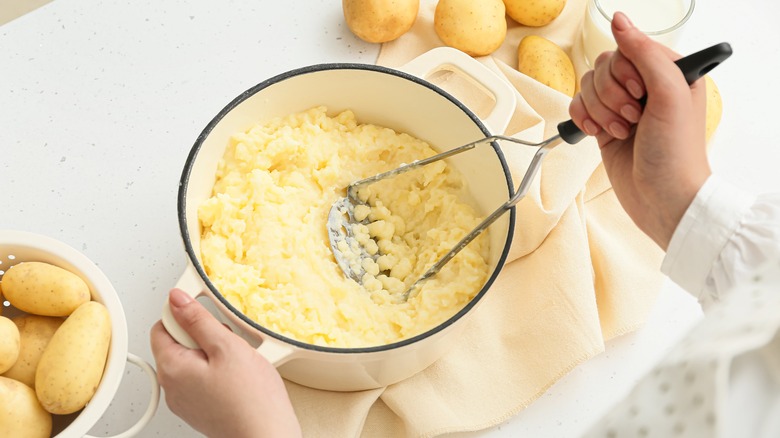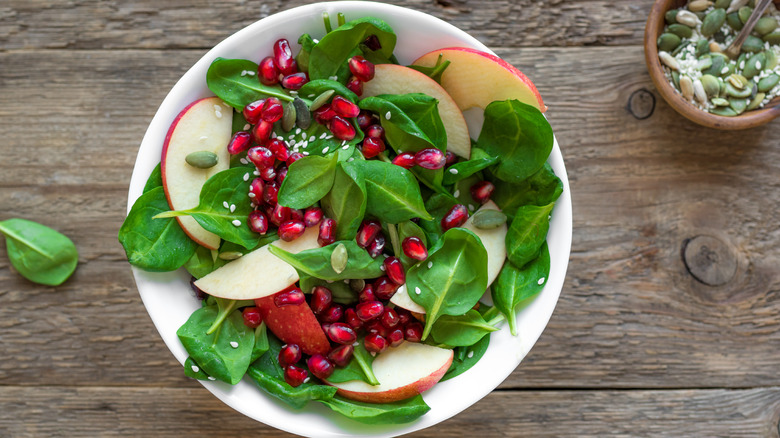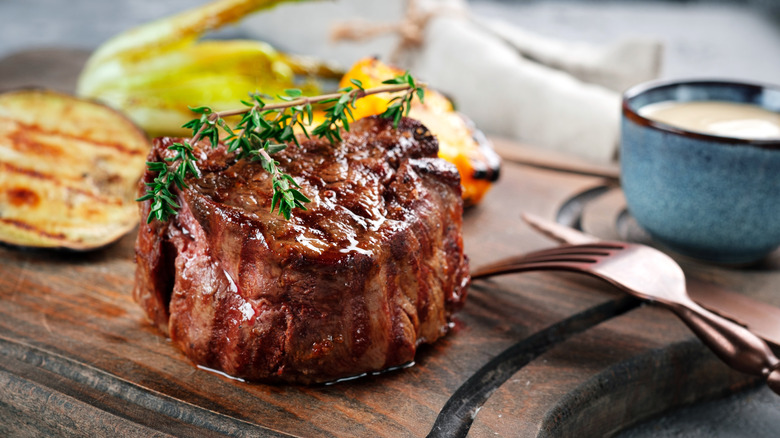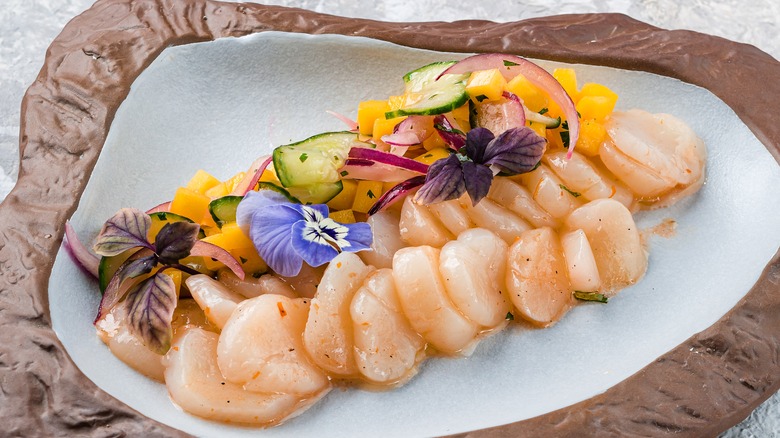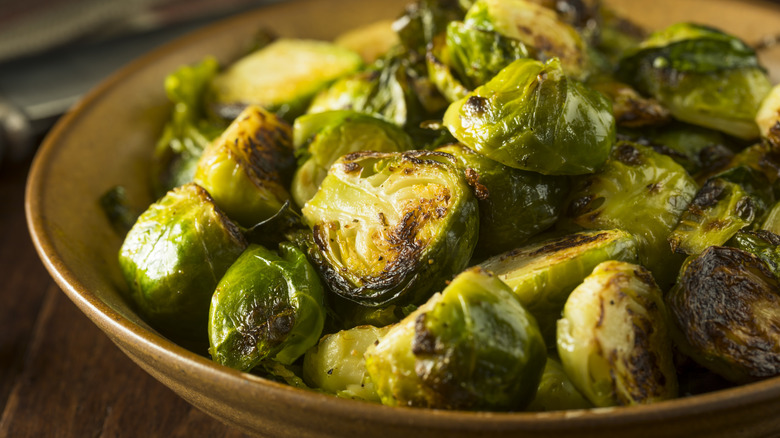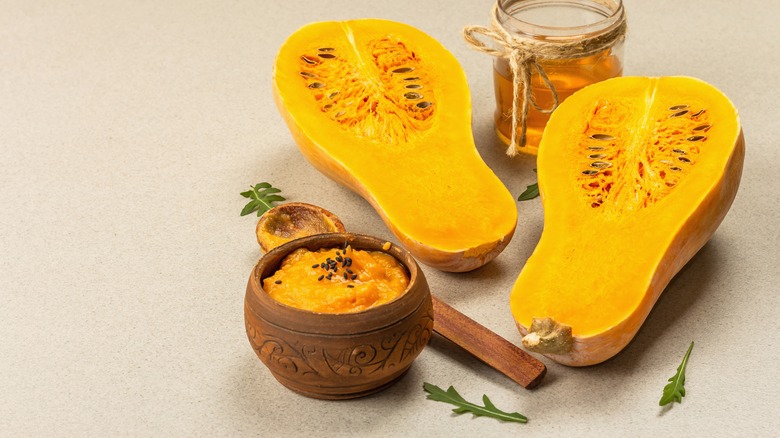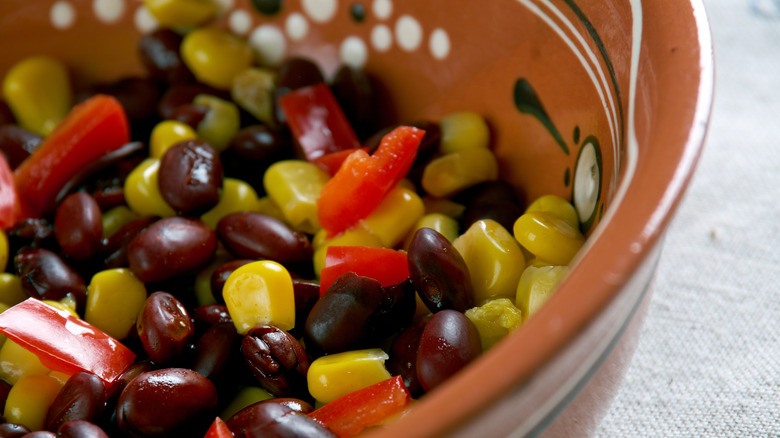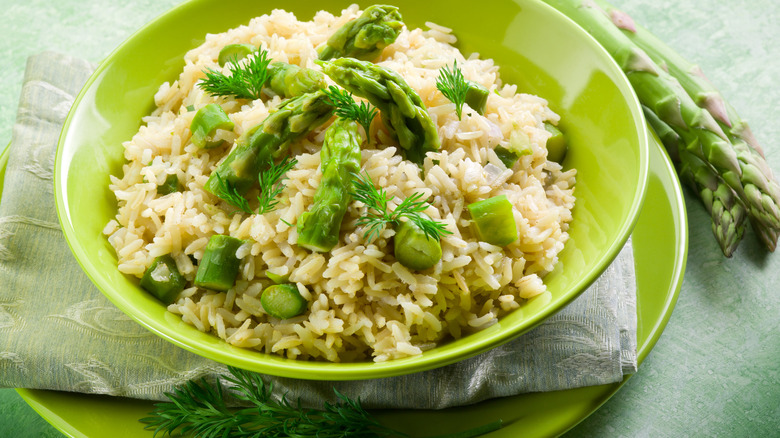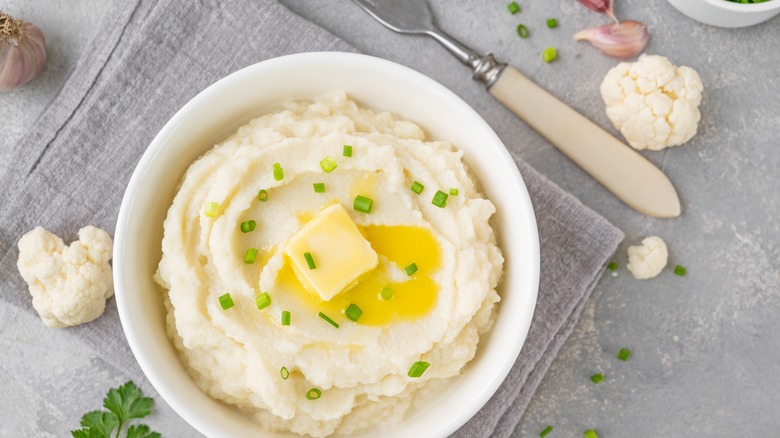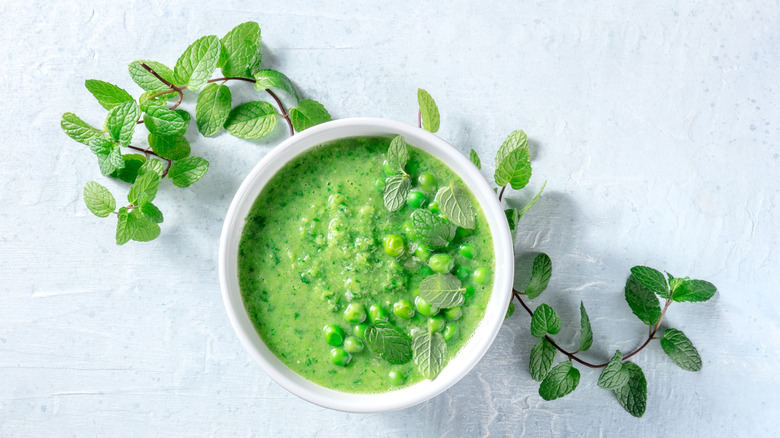The 12 Absolute Best Side Dishes For Scallops
Celebrity Chef Tom Colicchio once penned about scallops that the biggest compliment he might receive while cooking them is that the result tastes like a scallop (via the Vineyard Gazette). The chef urged listeners not to "over manipulate" this seafood. Indeed, we agree. No matter which water they are from, fresh scallops are as reliable as a sunrise. Whether seared, baked, grilled, roasted, or fried, scallops always deliver a sweet, briny, buttery, and slightly nutty flavor. Plus, scallops are as rich as anything you'll pull out of the ocean. As Colicchio states, this ocean gem tastes best when prepared simply — and, in our opinion — comes served with an accentuating side dish.
Cooking our scallops, we tend to stick with the classic "seared" preparation. Then, we went diving for the best side dishes to accompany these beautifully bulbous bivalves. We took Chef's reliable advice and included only recipes that would celebrate our sumptuous scallops and not hide them. What rose to the surface are simple-to-prepare recipes that are as mouth-watering as they are healthy, and we even got a little help from a few "odd-plate fellows."
Simply steamed spinach
In the food world, opposites attract. Pick your favorite: milk and cookies, tomato soup and grilled cheese, chocolate and peanut butter — our list of choices seems endless. As you build any main course, including opposing flavors, textures, and colors is always worthwhile. Since scallops are rich and sweet, why not pair them with something bitter? Fine Taste Club discusses how opposing flavors attract and explores the scientific approach to food pairing. Much of it comes down to "molecules harmonizing," where the more similar flavors tend to boost each other's lusciousness on a molecular level. Including "odd-plate fellows" in the meal often takes a different approach to merging flavors.
Spinach might not seem too odd of a choice because it's a standard go-to. Spread out on the plate, spinach is an excellent foundation for scallops. Since scallops have a relatively small surface space, a delicious sauce will often end up on the plate and not in your mouth, making spinach a great sauce catcher. Serving steamed spinach with a squirt of lemon allows opposing flavors to pull the sweet rug out from under the scallops. Bringing a bit of bitterness to the forefront allows for further deep dives back into sweet. Think of it like walking into an air-conditioned room on a hot summer day. Food opposites, as laid out by Fine Dining, can deliver.
Old-fashioned mashed potatoes
When scallops are bought from your local fishmonger, they're usually out of their shell, cleaned, and ready to cook. One thing about this seafood is that scallops are a bit expensive and might seem intimidating to cook, given the small size. If you've dealt with them before, you may already be familiar with common mistakes everyone makes when cooking scallops. But searing is straightforward, and you'll most likely spend more time perusing sauce options. Scallops shine best in a sauce unless you're eating them right out of the shell (but that's for another article).
There is an ocean of sauces to choose from, and most white fish sauces will work well. Lemon caper butter sauce adds to the brininess of the scallop, and a buttery orange ginger sauce offers a citrine and spicy flare. But here's the problem. Sea scallops, and especially bay scallops, have a small top surface. This is why mashed potatoes will come to the rescue in the art of "sauce catching." Make a batch of this creamy mashed potatoes recipe and serve your scallops on top. Mashed potatoes are relatively innocuous and allow the sweet scallops and your sauce of choice to sing as they take a backseat to the scallops in the texture department. Serve this with a crispy green salad with balsamic dressing to give the plate a bit of a bite and add some color to an otherwise pale plate.
Pomegranate spinach salad
Sticking with opposing flavors, a bitter-based fresh spinach salad with pomegranates adds a bit of sparkle and "pop" to the otherwise silky scallop texture. Is that fair to your tongue? Heck yea. Not only is it fun to hack your taste buds, but they enjoy the distraction. When a taste bud's environment is changed, they behave differently. BBC celebrates "taste bud hacking" and takes a glance behind your choppers. The five taste sensations: sourness, bitterness, sweetness, saltiness, and umami, are all delivered from your tongue. Each sensation is triggered by taste-sensitive cells within the tongue, and each of those cells is made up of proteins. Molecules in the food you eat trigger the proteins that send messages to the brain. Pomegranate and scallops offer contrasting sensations — the fruit literally bursts with a sweet and sour flush, while the scallops offer melting salty umami.
But let's not forget about some of our other senses. Now that we've astonished the taste buds let's sprinkle in texture and eye candy. To really take your senses on a magical mystery tour, add sliced apples to your salad. Now we're seriously introducing opposite flavors and textures! Plus, leafy greens make a good dietary addition thanks to an abundance of vitamins and nutrients. This is definitely true of spinach, and, let's face it, pomegranates are as fun as parade confetti, aren't they?
Beef tenderloin
We're going to veer off here in a couple of new directions. First, we'll swap out the more typical sea scallops and introduce bay scallops. Let's say it's winter, and imagine that you're lucky enough to live near a bay ... and that bay has bay scallops in it ... well, you've hit the seafood lottery! Bay scallops are more delicate popcorn-sized bivalves available from November through March. Besides size, the difference between bay scallops and sea scallops is bay scallops tend to be sweeter and more tender, making them more sought after. We'll further change things by having our "side dish" create a melt-in-your-mouth surf and turf meal. A juicy tenderloin with garlic butter sauce makes for a perfect pairing. Of course, now you have obvious opposing foods. From other worlds in the literal sense, beef and scallops meld together like sunshine and whiskey.
Add a buttery garlic sauce recipe to slather over the entire plate (and perhaps a luscious red Burgundy wine), and you've created "second date at my place" magic. For a dash of panache, serve a small, whole tenderloin with a giant sea scallop on top. However, we also like the bay scallops here as they offer a diminutive dimension to compliment the hunk of meat. Also, bay scallops are small and sweet, like candy, and fun as a go-to. A bit of earthy bitterness would make a perfect third in the form of fresh asparagus or broccoli.
Scallop ceviche
Feel like turning your dinner into a fiesta? Shrimp, fish, and tuna are in regular rotation on Mexican menus, but scallops should not be ignored here! The journal of Developments in Aquaculture and Fisheries Science explores the many trials and tribulations Mexico has undergone since first introducing bay scallops to commercial fisheries in the 1980s. Since then, scallops have become a staple in Mexico, giving delightful competition to the contrasting Peruvian ceviche. While scallops are scrumptious stuffed into a fire-charred taco with salsa verde, sour cream, chopped lettuce, and tomato, for a more "grown-up" dinner, skip the tortilla and "deconstruct" your ceviche! Fresh citrus fruits served with either type of scallops bring out their brininess and add to the coastal call of the wild.
So what will it be? Slices of orange, pineapple, or kiwi? Papaya or mango add a Caribbean twist. Whichever fruits your choose, add a drizzle of honey and a squirt of lime and sprinkle with coconut flakes. The honey softens the sweetness, and the avocado cuts through the citrus and acts like a creamy go-between. If you really want to feel like you're on vacation, save some of the avocado (or, more accurately, buy extra!) and make quick and easy guacamole to rest your scallops in. This will add extra creaminess to juxtapose the juicy fruits and add additional color without hiding the scallops. Wow, now we're getting hungry!
Oven-roasted Brussels sprouts
Brussels sprouts are currently enjoying their time in the spotlight and are as prevalent on restaurant menus as Nicholas Cage movies on Netflix. Brussels sprouts deliver a contrasting bitterness and add a crunch to the softer, buttery scallop, unlike spinach. Plus — sorry, Brussels sprouts haters — these things are darn good for you. Countless websites, including reputable medical-based sites from the US Department of Agriculture and Medical News Today to Harvard, love these little doo-dads. They all boast that Brussels sprouts are high in nutrients, antioxidants, fiber, vitamins C and K, omega 3 fatty acids, help maintain healthy blood sugar levels, and reduce inflammation.
Brussels sprouts are also a no-brainer to prepare. Just clean them up, cut them in half, parboil your Brussels spouts in salt water until fork-soft, and then roast them in the oven. Adding something sweet or tangy to your sprouts before placing them in the oven is a great way to add a bit of flash to your mouth, and the choices are endless-thinly sliced apples, raisins, dried cranberries, or onions work well. After taking them out of the oven, you can toss them in a drizzle of honey, cider vinegar, or balsamic reduction.
Winter vegetable purées
So we've been talking about opposing bite sensations but let's not get too far away from like-kind harmonies. Let's say you're serving scallops, and you've got that bitter component figured out (Brussels sprouts, for instance), but you still need a second side (and yes, you need a second side). Let's go with another sweet. Sweet potatoes are easily accessible year-round and make an excellent, sweet companion for scallops. If you enjoy eating sweet potato skin (and we know you're out there), this antioxidant-brimming tuberous root can add some crisp bitterness to the meal. But for our purposes, nothing can beat the candied goodness of the butternut squash.
A great source of fiber and vitamin A, butternut squash is loaded with health benefits and delivers sweetness to any dish (via Verywell Fit). Butternuts are also available year-round but really shine in the early fall through winter. Like spinach, butternuts can also be a great "sauce catcher" in the velvety form of savory mashed butternut squash purée. Although you're still pairing a saccharine squash with a sweeter variety of seafood, the different textures play well together.
Popular Science identifies a wide range of different food textures, which they break down into two main categories: "soft" and "crunchy." Combining these two contrasting textures naturally adds a spark to a potentially one-dimensional meal. In this case, the now softer sweet tuber puree lets the sear of the scallops take the crispier reins.
Cheesy smoked maple bacon grits
We've already established that seared scallops are rich, buttery, and have a touch of nuttiness. Adding a flavor component to round out your scallops can help improve the flavor. We're thinking of something sweet and something salty. As cliché as it sounds, adding bacon to most things rarely disappoints. Frying maple smoked bacon beforehand leaves you with some flavorful fat to sear the scallops in. It will also leave everyone at your table grinning from ear to ear (unless you've invited your cardiologist over). Now you've got all the fantastic components of the scallops with a full variety of flavors.
Keeping on the subject of bacon (and why not?), you can compliment your scallops by serving them with creamy maple bacon grits! Adding cheese, bacon, and maple to grits is a divine way to touch up classic shrimp and grits. With scallops, we're really just subbing out one marine animal for another, and since shrimp and scallops are as interchangeable as drummers in a rock-n-roll tribute band, your southern friends won't disown you. At sunrise, an argument heard 'round the breakfast table is about whether grits or oatmeal are healthier. With all of these proposed additions, the answer is probably neither. But, since we've found the absolute best way to reheat grits, a hearty cornmeal base wins out.
Summer succotash
Succotash was first introduced to European settlers by indigenous populations (via the New York Times). Although originally a cream dish, succotash has come to loosely represent any mix of chopped vegetables. For our purposes, a base of fresh corn and bell peppers will brighten the dinner plate beautifully. Beans are also called for; any of the most popular beans will do the trick. Wax, lima, black, kidney, navy, chick, edamame — whatever floats your bean boat. Succotash often includes meat, so adding fresh bacon bits or slices of grilled sausage gives smokiness and a surf-n-turf component to scallops. But the paramount part of any great succotash is freshness.
When winter bay scallops are in-season, you can still gain access to fresh summer vegetables for succotash. For the planner with a green thumb, websites like the National Center for Food Preservation offer quick instructions on canning your veggies so as to provide fresh goods even when the season has passed. Now that you've ensured your succotash is fresh, the textures should pop and deliver an equally pleasurable sensation. With succotash, you have all of the scallops' closest friends arriving at the party simultaneously — sweet corn, bright tomato, waxy beans, smoky bacon, and bittersweet peppers — how can this not work? By the way, the origin of succotash, says Cook's Info, is from the Narragansett people's word msickquatash, which translates from either "boiled corn kernels" or "broken into bits." Bring that up at dinner; now you've impressed the crowd.
Grilled asparagus and lemon risotto
There's not much more "old school" than making Italian risotto. The history of risotto tracks with the history of rice in Italy, dating back to when the Moors introduced it to the country during the Middle Ages. The high humidity of the Mediterranean proved perfect for cultivating short-grained rice with high starch content. Because short-grain types of rice have a higher makeup of starch, this rice is less absorbent and gives cooked risotto a pasta-like texture. Risotto is a great way to capture every last drop of whichever delicious sauce coats your scallops while adding dimensions and flavors.
Following our theme of celebrating our scallops rather than hiding them, fresh squirts of lemon is a bright and clean alternative to the popular Italian tomato-based preparations, which is why we like it in our risotto. Considering how opposite flavors and textures attract, adding asparagus brings dimension to the risotto and another texture to the plate, offsetting the creamy base and the supple scallop to give the dish a bit of crunch. For some smokiness, we recommend our grilled asparagus recipe. Simply roll your raw asparagus around in a large plastic bag with lemon, olive oil, salt, and pepper and lightly char them on the grill.
Creamy cauliflower purée
For the diehard vegan who's been scrolling and scrolling, here's your stop. Low in carbs and high in nutrients, cauliflower has made a considerable mark in the Keto diet world. Scientifically, it's known as Brassica oleracea, variety botrytis, per Brittanica, but informally it's been spied around town disguised as anything from pizza crust and rice to the "mac" in mac and cheese. Sure, you can roast cauliflower, and you would make a perfect partner for your scallops, but we have to think about that sauce. Something lemony? Maybe some orange with maple? You'll be a bit happier having the consistency of creamy cauliflower for the same reasons as using mashed potatoes. Plus, mashed cauliflower purée recipes are wicked easy to make. Just cut out the florets, blanch them in a pot until soft and then put it in a food processor.
One recipe we like adds nutmeg, which pairs well with the scallops' nutty undertones, but the great thing about using a blender is that you can add to your concoction as the mood hits you! Why not sprinkle in liberal amounts of Parmesan for cheesiness? Few friends will push themselves away from the table because of cheese. It also reheats well, so don't be afraid to make too much!
Minted mushy peas with truffle oil
Mushy peas, despite their name, have a strong history in English cuisine. According to British Magazine, they add a sense of grandeur to any dish. In fact, mushy peas now have a national day of celebration (it's November 8, in case you want to pull out your green sweater). In this instance, we like a combination of whole peas with mashed. Whole peas add the pop, but since our pea and scallop meal is pretty spherical (and has the potential to pinball around the plate), a nest of mashed peas keeps some order. Plus, it's nice to combine the soft with the snap. Why? That's right! Another texture dimension. Green is also a lovely color to offset beautiful pearly-white scallops.
When it comes to the power of the pea, WebMD reminds us that the pea packs a big punch and aren't as "humble" as they look, delivering a not-so-pea-sized list of nutrients and health benefits to the table, which include eye, heart, and digestive health. Peas also multitask in your mouth, combining sweet and vegetal with savory and earthy. Adding fresh mint just before serving creates a bright and cooling sensation (if you're not a fan of mint, dill or basil work just as boldly). After preparing your mushy pea recipe, a dash of truffle oil to the minted peas and seared scallops makes this simple dish a trifecta of elegance (or is that a hat trick? We'll get back to you on that).
